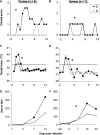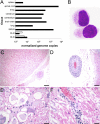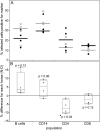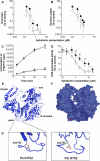A point mutation in a herpesvirus polymerase determines neuropathogenicity
- PMID: 17997600
- PMCID: PMC2065875
- DOI: 10.1371/journal.ppat.0030160
A point mutation in a herpesvirus polymerase determines neuropathogenicity
Abstract
Infection with equid herpesvirus type 1 (EHV-1) leads to respiratory disease, abortion, and neurologic disorders in horses. Molecular epidemiology studies have demonstrated that a single nucleotide polymorphism resulting in an amino acid variation of the EHV-1 DNA polymerase (N752/D752) is significantly associated with the neuropathogenic potential of naturally occurring strains. To test the hypothesis that this single amino acid exchange by itself influences neuropathogenicity, we generated recombinant viruses with differing polymerase sequences. Here we show that the N752 mutant virus caused no neurologic signs in the natural host, while the D752 virus was able to cause inflammation of the central nervous system and ataxia. Neurologic disease induced by the D752 virus was concomitant with significantly increased levels of viremia (p = 0.01), but the magnitude of virus shedding from the nasal mucosa was similar between the N752 and D752 viruses. Both viruses replicated with similar kinetics in fibroblasts and epithelial cells, but exhibited differences in leukocyte tropism. Last, we observed a significant increase (p < 0.001) in sensitivity of the N752 mutant to aphidicolin, a drug targeting the viral polymerase. Our results demonstrate that a single amino acid variation in a herpesvirus enzyme can influence neuropathogenic potential without having a major effect on virus shedding from infected animals, which is important for horizontal spread in a population. This observation is very interesting from an evolutionary standpoint and is consistent with data indicating that the N752 DNA pol genotype is predominant in the EHV-1 population, suggesting that decreased viral pathogenicity in the natural host might not be at the expense of less efficient inter-individual transmission.
Conflict of interest statement
Figures







References
-
- USDA-APHIS. Equine herpes virus myeloencephalopathy: A potentially emerging disease. 2007. Available: http://www.aphis.usda.gov/vs/ceah/cei/taf/emergingdiseasenotice_files/eh.... Accessed 04 June 2007.
-
- Kydd JH, Smith KC, Hannant D, Livesay GJ, Mumford JA. Distribution of equid herpesvirus-1 (EHV-1) in respiratory tract associated lymphoid tissue: Implications for cellular immunity. Equine Vet J. 1994;26:470–473. - PubMed
-
- Allen GP, Bryans JT. Molecular epizootiology, pathogenesis, and prophylaxis of equine herpesvirus-1 infections. Prog Vet Microbiol Immunol. 1986;2:78–144. - PubMed
-
- Edington N, Bridges CG, Patel JR. Endothelial cell infection and thrombosis in paralysis caused by equid herpesvirus-1: Equine stroke. Arch Virol. 1986;90:111–124. - PubMed
Publication types
MeSH terms
Substances
Associated data
- Actions
- Actions
- Actions
- Actions
Grants and funding
LinkOut - more resources
Full Text Sources
Other Literature Sources

